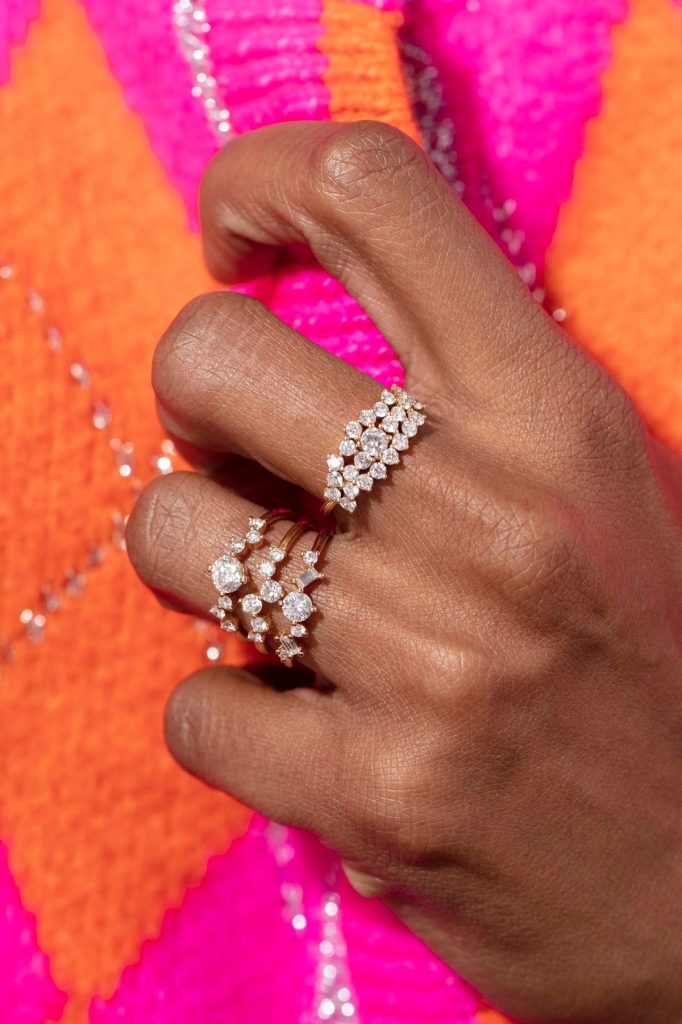From Place Vendôme, home to the Ritz and Paris’ most prestigious heritage jewelry houses, to a relaxed apartment showroom in the city’s 17th arrondissement for Héloise et Abelard, her own brand of circular jewelry, Héloise Shapiro has crossed not only her native city, but also a gulf of expectation. “When I left Place Vendôme, I had a visceral desire to do things differently,” she tells me. “I knew that my brand had to use recycled materials, as goldsmiths always have done by saving their waste gold to melt down and reuse.” But better still, it was going to be upcycled.
Today, Shapiro and her team scour the city’s antiques stores, pawn shops and auction rooms for second-hand stones and antique jewelry to be taken apart and re-made into contemporary designs with a fresh, modern look at an accessible price point. Customers can buy a slim gold band for $450, while her distinctive diamond cluster rings start at $1,900, and while recycling precious metals is nothing new – even if the savings are not always passed onto the customer – producing repeat collections from second-hand materials, is. And customers – including Katie Holmes, who was recently seen wearing an upcycled Héloise et Abelard tourmaline and diamond ring – love it.
Named after two 12th century lovers in Paris, Héloise and Abelard’s circular jewelry is surely the ultimate expression of the romance of natural diamonds. The bulk of Shapiro’s clientele is aged 25-35 and shopping for wedding and engagement rings; a customer base she describes as “well-off, thoughtful and informed” and looking for something more original and heartfelt than the cookie-cutter styles of her old stomping ground. But she also has older clients for her diamond-set, organically shaped gold medallions, and sometimes mothers and daughters, who come with their own stones for re-setting, something the designer remembers happening regularly in her own family.
“My mother and grandmother were big fans of vintage jewelry and bold styles,” she says. “I remember them having jewels regularly set and re-set. To me, that seemed normal, so I became quite disgusted with the widely used economic model in the jewelry industry, that doesn’t factor in re-use.”
Shapiro spent 10 years on Place Vendôme working in product and marketing, developing business expertise and built a substantial network in the jewelry world. Thanks to her hard-won experience and connections, today she can partner with a family-run Paris fine jewelry atelier that also works for Hermès and Chanel on production, with a four-week lead time. The available raw materials are the starting point for her designs and pieces are produced in limited numbers while materials last; once it’s gone, it’s gone – a daunting prospect, but rarity breeds exclusivity.
“At first, asking people to wait four weeks was scary, but I soon realised the product had such resonance that they were prepared to do it. ” Making to measure is the most cost-effective and low-risk way of producing jewelry, with minimal wastage, reliably low prices in comparison to the fluctuating prices of freshly mined diamonds, and no need to carry stock.
Shapiro launched her brand during the pandemic, building the website herself in lockdown in Normandy, at a time when sustainability was not as developed in France as it is now. Growth has been organic and based solely on social networks, and now in her fourth year of trading, she reports +30% year-on-year and is “excited” about exploring international retail opportunities.
Couldn’t such a dynamic model streamline costs even further by using lab-grown diamonds? “Lab-grown is an interesting alternative,” she say diplomatically. “But it’s very energy-heavy and I’m not sure we really know enough about it yet. Aside from that, prices can be a little arbitrary.” She sees a place for above-ground diamonds in fashion jewelry, but “part of the value of natural diamonds lies in how they were created and the idea of handing them down the generations.”
Most importantly, Shapiro is having fun as she quietly disrupts the market with a local-first, ethical approach, a small but agile team and prudent financial management. The most ethical action, would be not to wear diamonds at all, but for those for whom the pull of the eternal stone is too strong, Héloise et Abelard’s glittering clusters of diamonds infused with history, are surely a worthy alternative.
Héloise et Abelard is available online at and at Le Printemps and La Samaritaine department stores in Paris.
Read the full article here










